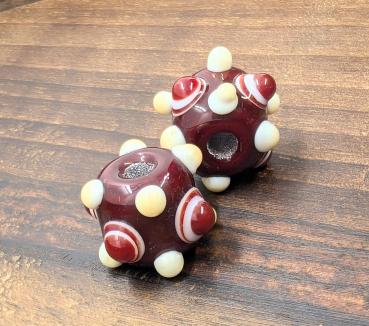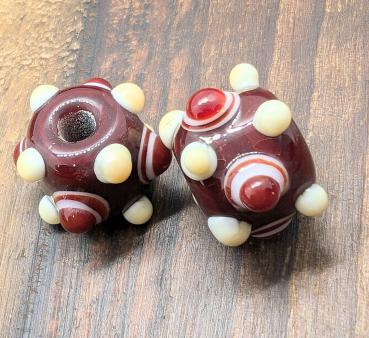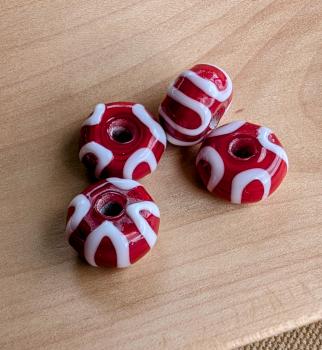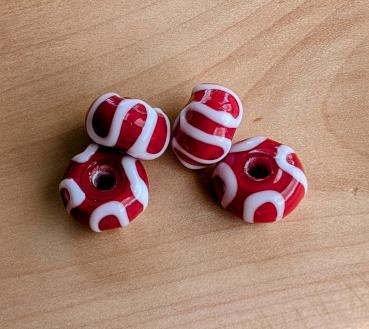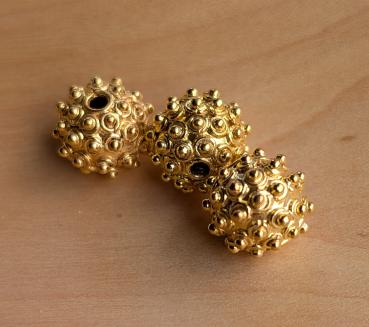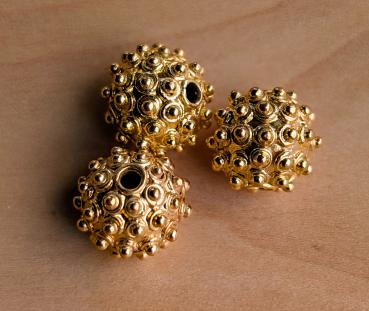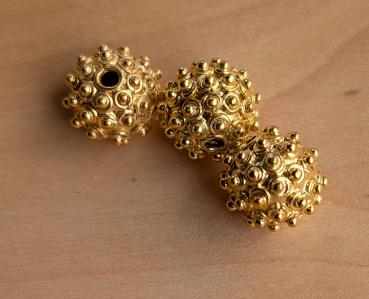Nächste Termine:
17.+18.05.2025 Germanische Siedlung Klein Köris (PLZ 15746)
29.05.-01.06.2025 Burgfest Neustadt Glewe (PLZ 19306)
Herzlich Willkommen im Onlineshop für
Glasperlen und Schmuck mit Geschichte
Willkommen im Hagedisenhain Onlineshop. Ich biete handgefertigte Glasperlen nach Fundvorlagen aus verschiedenen Ausgrabungsstätten in Europa, sowie kreativen Glasschmuck.
Fragen und spezielle Wünsche können gerne über mein Kontaktformular gestellt werden.
.jpg)
Seit mehreren tausend Jahren fasziniert die Menschheit in allen Kulturen Schmuck in verschiedenen Variationen. Und schon früh fertigten die Menschen ihre Schmuckstücke aus den unterschiedlichsten Materialien: Gold, Silber, Bronze, Knochen, Stein – und Glas. Eine der ältesten belegten Art für Glasschmuck sind die nach ihrer Herstellungsweise benannten Wickelglasperlen.
Glas selbst wurde wahrscheinlich zum ersten Mal ca. 3500 v. Chr. in Mesopotamien und Anatolien produziert. Allgemein wird angenommen, dass die Herstellung von Glas durch „Zufall“ entdeckt wurde. Durch Zugabe von Metalloxiden zum Rohglas entstehen die unterschiedlichsten Farbtöne.
Wenn Sie im Shop durch die einzelnen Kategorien schauen, können Sie die Farbvielfalt entdecken.
Lassen Sie sich von den matten, oft porösen Glasperlen in manchen Museumsvitrinen nicht verwirren. Mit Sicherheit war der Glasschmuck unserer Vorfahren genauso bunt und strahlend, wie heute hergestellte Glasperlen. Die „Mattigkeit“ wurde durch die Säuren der Erdschichten hervor gerufen, in denen die Perlen zum Teil Jahrtausende lagen.
Ich fertige Glasperlen auf historischen Märkten und Stadtfesten in einer Holzkohle-Esse mit Blasebalg. Besucher, die es selbst versuchen möchten, können dies unter meiner Anleitung tun und so ihre eigene Glasperle herstellen und als Andenken mitnehmen. Die Glasperlen für den Verkauf an meinem Handwerksstand und hier im Onlineshop fertige ich an einem modernen Zwei-Gas-Brenner in meiner Werkstatt in Berkenbrück in Brandenburg. Durch umfangreiche Recherchen, zahlreiche Museumsbesuche und viele Experimente bin ich mittlerweile in der Lage, ein breites Spektrum von Perlen der Kelten, Germanen, Wikinger, Slawen und anderer Kulturen herstellen zu können. Immer wieder setze ich auch andere Ideen um und erfülle Wünsche für modernen Glasschmuck und ganz besondere Unikate.
Die verwendeten Gläser beziehe ich zum Beispiel von der Farbglashütte Lauscha in Thüringen (Deutschland), von der Firma Effetre bei Murano in Venedig (Italien) und von der Glashütte Reichenbach in Sachsen (Deutschland).

Unsere Empfehlungen
Neue Artikel
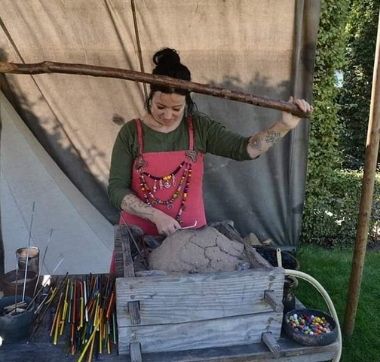
Die Geschichte vom Hagedisenhain Onlineshop
Nachdem ich 1999 meine Firma gründete, begann ich zunächst damit, im Internet Kräuter und Harze zum Räuchern und Halbedelsteinschmuck zu verkaufen. Meine erste Webseite programmierte ich noch selbst, ebenso den aller ersten Onlineshop. Mittlerweile vertraue ich hier lieber den Profis auf diesem Gebiet und widme mich ganz meiner handwerklichen Arbeit.
Als ich ca. 2001 das erste Mal für ca. eine Woche im Museumsdorf Ribe (Dänemark) zu Gast war, machte ich erste Erfahrungen an der Glasperlen-Esse. Das war im Nachgang auch meine erste, tatsächliche Begegnung mit dem Werkstoff Glas. Und das, wo ich im Süden Thüringens geboren wurde und das Glas fast in der Wiege lag. Aber eben nur fast und so musste ich wohl den Umweg über Dänemark nehmen. Meine ersten, selbst hergestellten Glasperlen weckten in mir den Drang, mehr über dieses alte Handwerk zu erfahren. Ich recherchierte und übte an einem einfachen Baumarkt-Gasbrenner. Die farblichen Ergebnisse waren sehr unbefriedigend, weshalb ich bald auf einen Zwei-Gasbrenner umstieg. Durch das Zuführen von Sauerstoff verbrennt das Gas sehr viel sauberer und es gelangen keine Verunreinigungen ins Glas, welche mit den Metalloxiden reagieren könnten.
Das Abkühlen der Perlen und Schmuckstücke kann Spannungen im Glas aufbauen, die zu feinen Haarrissen führen, welche man vielleicht zunächst nicht sieht. Aber im Laufe der Zeit könnten die Perlen zerbrechen. Auf Grund dieser Erfahrungen nutze ich einen guten, digital gesteuerten Ofen zum tempern der Glasperlen. So kann ich, bei sachgemäßem Gebrauch der Glasstücke (Perlen, Schmuck, Figuren) für ihre Langlebigkeit garantieren. Für die Verarbeitung der Glasperlen zu Schmuck verwende ich hauptsächlich 925 Sterlingsilber oder Baumwollbänder.
Der Glasschmuck unterscheidet sich erheblich von industriell hergestellter Massenware. Jede Glasperle hat ihren eigenen Charme, ihre eigene farbige Strahlkraft.

Auch wenn sich vieles in den letzten zwei Jahrzehnten in meiner Arbeit und meinem Leben geändert hat, der Name „Hagedisenhain“ ist geblieben. Viele Male hatte ich überlegt, den Namen zu ändern und etwas mehr auf „Glas“ bezogenes zu finden. Aber letztlich gehört der Hagedisenhain zu mir. So wie das alte Handwerk der Glasperlenherstellung.






